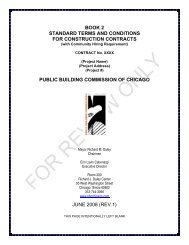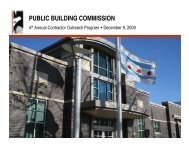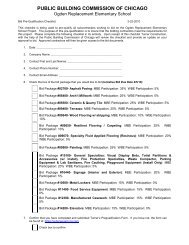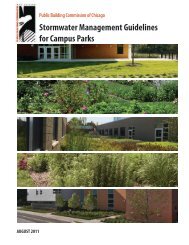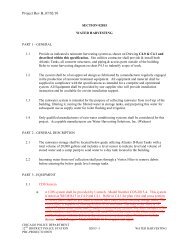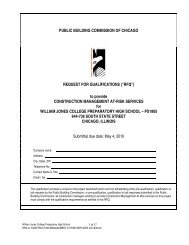Water Reuse Handbook - the Public Building Commission of Chicago
Water Reuse Handbook - the Public Building Commission of Chicago
Water Reuse Handbook - the Public Building Commission of Chicago
Create successful ePaper yourself
Turn your PDF publications into a flip-book with our unique Google optimized e-Paper software.
<strong>Water</strong> <strong>Reuse</strong> <strong>Handbook</strong><br />
Introduction: Benefits <strong>of</strong> <strong>Water</strong> <strong>Reuse</strong><br />
Benefits <strong>of</strong> <strong>Water</strong> <strong>Reuse</strong><br />
Introduction<br />
2 : <strong>Public</strong> <strong>Building</strong> <strong>Commission</strong> <strong>of</strong> <strong>Chicago</strong><br />
The City <strong>of</strong> <strong>Chicago</strong> was founded, in large part, due to its location at<br />
<strong>the</strong> junction <strong>of</strong> <strong>the</strong> <strong>Chicago</strong> River and Lake Michigan, as well as at<br />
<strong>the</strong> convergence <strong>of</strong> <strong>the</strong> Mississippi River and Great Lakes watersheds.<br />
It promised superior transportation, enhanced trade opportunities,<br />
and ease <strong>of</strong> access for visitors. Nearly 20 percent <strong>of</strong> <strong>the</strong> earth’s and<br />
95 percent <strong>of</strong> <strong>the</strong> nation’s fresh water supply is found in <strong>the</strong> Great<br />
Lakes. While <strong>the</strong> region’s fresh water supply may appear endless,<br />
<strong>the</strong>re are compelling reasons to initiate comprehensive conservation<br />
methods--<strong>the</strong>se efforts are in line with a Supreme Court 1967 ruling<br />
that limits Lake water diversion rates to 3,200 cubic feet per second,<br />
regardless <strong>of</strong> <strong>the</strong> future development or population growth <strong>the</strong> area<br />
has experienced. Policy documents <strong>of</strong> many major regional planning<br />
agencies, such as <strong>the</strong> <strong>Chicago</strong> Metropolitan Agency for Planning<br />
and <strong>the</strong> Alliance for <strong>the</strong> Great Lakes, emphasize potable water use<br />
reduction to ensure <strong>the</strong> region’s ongoing water vitality.<br />
<strong>Water</strong> levels in Lake Michigan have been falling, with only one<br />
percent <strong>of</strong> <strong>the</strong> water in <strong>the</strong> Lake renewed each year. Ground water<br />
levels have declined between 300 and 800 feet in <strong>the</strong> region, fur<strong>the</strong>r<br />
lowering Lake water levels. At <strong>the</strong> same time, demand for water<br />
is expected to increase over <strong>the</strong> next 20 years, with a projected<br />
population increase <strong>of</strong> 20% in <strong>the</strong> <strong>Chicago</strong>-Milwaukee region. With<br />
both increasing demand and decreasing supply, it is critical for <strong>the</strong><br />
<strong>Chicago</strong> area to take prudent and sustainable measures to safeguard<br />
against a dwindling fresh water supply.<br />
At <strong>the</strong> same time, <strong>the</strong> <strong>Chicago</strong>land area is experiencing increased<br />
incidences <strong>of</strong> local flooding each year due to severe storms; flooding<br />
within <strong>the</strong> City alone is largely a result <strong>of</strong> <strong>the</strong> City’s high water table<br />
and combined sewer system (a sewer system in which wastewater<br />
and stormwater are combined and treated in <strong>the</strong> same way). The<br />
combined sewer system occasionally overflows (called a combined<br />
sewer overflow or CSO) during major storm events, causing sewer<br />
contents to discharge into a waterbody, such as Lake Michigan or <strong>the</strong><br />
<strong>Chicago</strong> River. Prevention <strong>of</strong> such flooding is important to minimize<br />
<strong>the</strong> cost <strong>of</strong> damages as well as to protect water quality. These issues<br />
can be at least partially ameliorated by reusing water and reducing<br />
<strong>the</strong> load on <strong>the</strong> municipal sewer infrastructure.<br />
Carter H. Harrison water intake crib 2 miles from <strong>the</strong><br />
Lake Michigan shore (1910)<br />
http://en.wikipedia.org/wiki/File:HARRISON-<br />
CRIB-1910.jpg<br />
August 2011




